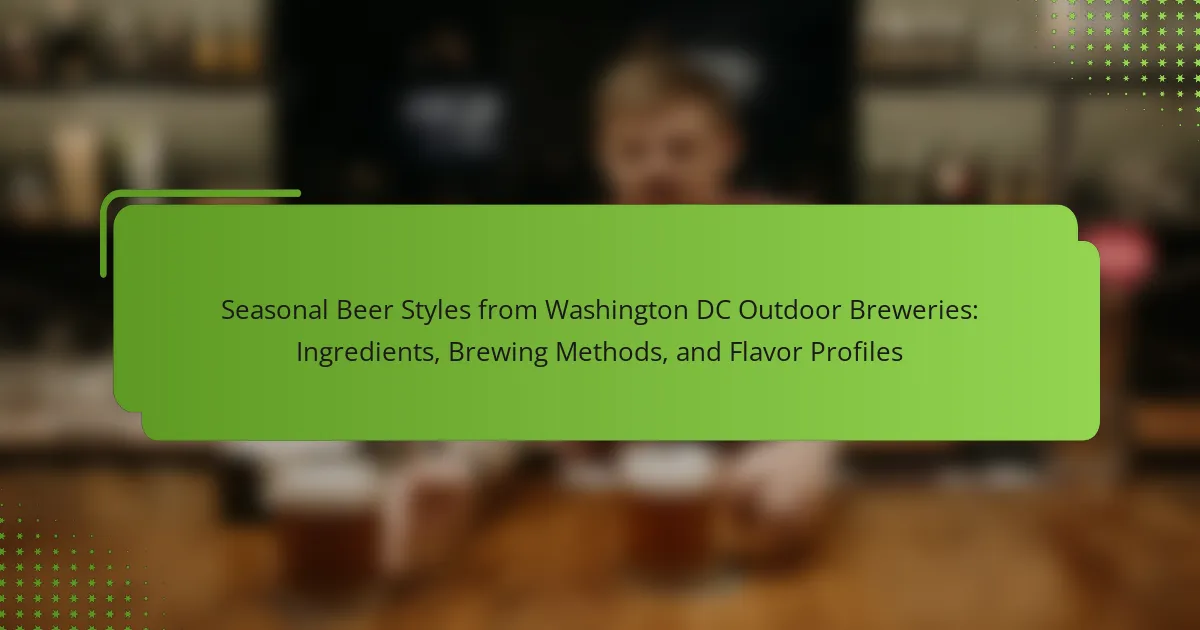Seasonal beer styles from Washington DC outdoor breweries include summer ales, fall harvest beers, winter warmers, and spring IPAs, each characterized by distinct flavor profiles and ingredient choices. Summer ales are light and refreshing, often brewed with citrus and floral hops, while fall harvest beers incorporate seasonal ingredients like pumpkin and spices. Winter warmers feature rich, malty flavors such as caramel and toffee, and spring IPAs are hop-forward with bright, fruity notes. Local breweries experiment with regional ingredients, enhancing the diversity of flavors and reflecting the area’s agricultural offerings. To fully enjoy these seasonal beers, it is recommended to pair them with complementary foods and engage with brewery staff for tailored recommendations.

What are Seasonal Beer Styles from Washington DC Outdoor Breweries?
Seasonal beer styles from Washington DC outdoor breweries include summer ales, fall harvest beers, winter warmers, and spring IPAs. Summer ales are often light and refreshing, brewed with citrus and floral hops. Fall harvest beers typically incorporate seasonal ingredients like pumpkin and spices. Winter warmers are rich and malty, often featuring flavors like caramel and toffee. Spring IPAs are usually hop-forward, showcasing bright and fruity notes. These styles reflect local brewing traditions and seasonal ingredients available in the region.
How do seasonal beer styles differ from regular beer styles?
Seasonal beer styles differ from regular beer styles primarily in their ingredients and flavor profiles. Seasonal beers are crafted to reflect specific seasons or holidays. For example, winter ales often include spices like cinnamon and nutmeg. These ingredients enhance the seasonal experience and cater to changing consumer preferences. Regular beer styles maintain consistent recipes year-round. They focus on classic flavors and traditional brewing methods. Seasonal beers can also have varying alcohol content, with some styles being stronger to suit colder months. This differentiation allows breweries to create unique offerings that resonate with consumers during specific times of the year.
What factors influence the seasonal availability of beer styles?
Seasonal availability of beer styles is influenced by factors such as ingredient availability, climate, and consumer preferences. Certain ingredients, like fresh hops or seasonal fruits, dictate when specific styles can be brewed. For example, pumpkin ales are typically brewed in late summer or early fall when pumpkins are harvested. Climate impacts brewing schedules; warmer months favor lighter beers, while colder months see an increase in stouts and porters. Consumer preferences also shift with the seasons, leading breweries to create styles that align with seasonal festivities and weather conditions. Historical trends indicate that breweries often release limited-edition seasonal beers to attract customers during specific times of the year.
Why are outdoor breweries significant in Washington DC?
Outdoor breweries are significant in Washington DC because they enhance the local craft beer culture. They provide unique spaces for socializing and enjoying the outdoors. Many outdoor breweries feature seasonal beers that reflect local ingredients and flavors. This connection to the community fosters a sense of place and identity. Additionally, outdoor settings attract diverse crowds, promoting inclusivity. Events and activities hosted at these breweries further engage the public. The growth of outdoor breweries also contributes to the local economy. They create jobs and support nearby businesses, reinforcing community ties.
What are the key ingredients used in seasonal beers from Washington DC?
Seasonal beers from Washington DC commonly use ingredients such as malt, hops, yeast, and various adjuncts. These beers often incorporate local seasonal fruits and spices. For example, pumpkin is popular in fall brews, while citrus fruits are used in summer ales. The choice of malt affects the beer’s color and flavor profile. Hops contribute bitterness and aroma, while yeast impacts fermentation and taste. Seasonal variations allow breweries to showcase unique flavors and ingredients. This approach reflects local agricultural trends and seasonal availability.
How do local ingredients impact the flavor profiles of seasonal beers?
Local ingredients significantly enhance the flavor profiles of seasonal beers. They introduce unique tastes that reflect the region’s terroir. Seasonal beers often utilize fruits, spices, and grains sourced locally. For example, using fresh hops from nearby farms can impart vibrant citrus notes. Similarly, local fruits like cherries or peaches can add sweetness and tartness. The freshness of these ingredients can elevate the overall aroma and taste. Furthermore, seasonal variations can create distinct flavors that resonate with local traditions. This practice fosters a connection between the beer and its community. Local ingredients ultimately enrich the drinking experience by celebrating regional characteristics.
What unique ingredients are often featured in Washington DC seasonal beers?
Washington DC seasonal beers often feature unique ingredients such as local fruits, spices, and herbs. Commonly used local fruits include cherries, blackberries, and peaches. Seasonal spices like cinnamon and nutmeg are frequently added for warmth. Additionally, herbs such as basil and mint can enhance flavor profiles. These ingredients reflect the region’s agricultural diversity. Breweries often source them from local farms, promoting community engagement. This practice supports sustainability and freshness in brewing. Seasonal beers in DC highlight the area’s rich culinary heritage and creativity.
What brewing methods are commonly used by outdoor breweries in Washington DC?
Outdoor breweries in Washington DC commonly use methods such as traditional brewing, barrel-aging, and kettle souring. Traditional brewing involves the standard process of mashing, boiling, fermenting, and conditioning. Barrel-aging adds complexity by aging beer in wooden barrels, which imparts unique flavors. Kettle souring is a method where lactobacillus is introduced during the brewing process to create a tart flavor. These methods reflect the innovative approaches of outdoor breweries in the region. Each method contributes distinct characteristics to the seasonal beer styles produced.
How do traditional brewing methods compare to modern techniques?
Traditional brewing methods rely on time-honored techniques, while modern techniques utilize advanced technology. Traditional methods often involve manual processes and natural ingredients. This can include open fermentation and spontaneous yeast. Modern brewing techniques often employ automation and precise temperature control. This allows for consistent results and faster production times. Traditional brewing may produce unique flavors due to local yeast and ingredients. Modern brewing can replicate flavors across different batches using standardized yeast strains. Both methods contribute to diverse beer styles, but they reflect different philosophies in brewing.
What role does the brewing environment play in the final product?
The brewing environment significantly influences the final product in beer production. Factors such as temperature, humidity, and air quality affect yeast activity and fermentation. For instance, warmer temperatures can enhance yeast metabolism, leading to faster fermentation. Conversely, lower temperatures may slow down the process and create different flavor profiles. Additionally, the presence of wild yeast and bacteria in outdoor environments can introduce unique flavors. The brewing environment also impacts the clarity and stability of the beer. A controlled environment helps maintain consistency across batches. Overall, these environmental factors play a crucial role in determining the taste, aroma, and quality of the beer produced.

How do flavor profiles vary among seasonal beers from Washington DC?
Flavor profiles among seasonal beers from Washington DC vary significantly based on the ingredients and brewing methods used. Spring seasonal beers often feature floral and citrus notes, utilizing hops like Citra and Amarillo. Summer beers typically emphasize lightness and refreshment, showcasing fruity flavors from ingredients like peaches or citrus peels.
Fall seasonal beers tend to incorporate spices such as cinnamon and nutmeg, reflecting autumn themes. Winter beers often have richer, malt-forward profiles with flavors like chocolate and coffee, enhanced by warming spices. Each seasonal beer captures the essence of its respective season through unique ingredient combinations and brewing techniques.
Local breweries frequently experiment with regional ingredients, further diversifying flavor profiles. For example, some may incorporate local honey or seasonal fruits, creating distinct tastes that reflect the area’s agricultural offerings. This variation contributes to a dynamic beer culture in Washington DC, appealing to a wide range of palates.
What are the most common flavor profiles found in these seasonal beers?
The most common flavor profiles found in seasonal beers include fruity, spicy, malty, and hoppy notes. Fruity flavors often come from the use of citrus, berries, or stone fruits. Spicy notes may arise from seasonal spices like cinnamon or cloves, especially in winter brews. Malty profiles are typically rich and caramel-like, contributing sweetness and body to the beer. Hoppy flavors, often present in spring and summer seasonal beers, can range from floral to herbal, depending on the hop varieties used. These profiles reflect the seasonal ingredients and brewing techniques favored by Washington DC outdoor breweries.
How do seasonal changes affect the flavor profiles of beers?
Seasonal changes significantly influence the flavor profiles of beers. Different seasons inspire brewers to use various ingredients. For instance, summer often features lighter beers with citrus and floral notes. These flavors are refreshing and complement warm weather. In contrast, winter beers tend to be richer and maltier. They often include spices like cinnamon and nutmeg, which evoke warmth.
Fall beers frequently incorporate pumpkin and caramel flavors, aligning with harvest themes. Seasonal ingredients like fresh hops are used in spring, enhancing the beer’s aroma and taste. Breweries may also adjust brewing methods to emphasize seasonal characteristics. The temperature and humidity during brewing can affect fermentation and flavor development.
Research indicates that consumer preferences shift with the seasons, impacting the styles produced. For example, a survey by the Brewers Association found that seasonal beers account for a significant portion of craft beer sales. This demonstrates the importance of aligning flavor profiles with seasonal trends.
What tasting notes should consumers expect from these seasonal offerings?
Consumers can expect a range of tasting notes from these seasonal offerings. Common flavors include citrus, floral, and herbal notes. Many seasonal beers feature hints of spice, such as cinnamon or nutmeg. Additionally, some may have fruity undertones, like berry or stone fruit. The use of fresh ingredients often enhances the overall flavor profile. For example, local hops can impart unique characteristics. The brewing methods also influence the final taste. Seasonal offerings may showcase the complexity of flavor that evolves with temperature and time.
Why is it important to understand the flavor profiles of seasonal beers?
Understanding the flavor profiles of seasonal beers is crucial for enhancing the drinking experience. Flavor profiles dictate how a beer tastes and smells. Seasonal beers often feature unique ingredients that reflect the time of year. For instance, autumn beers may include spices like cinnamon or nutmeg. This understanding helps consumers select beers that match their preferences. It also allows brewers to craft beers that resonate with seasonal themes. Knowledge of flavor profiles can lead to better food pairings. Seasonal beers often evoke emotions tied to specific seasons, enriching social experiences.
How can knowledge of flavor profiles enhance the beer tasting experience?
Knowledge of flavor profiles enhances the beer tasting experience by allowing tasters to identify and appreciate various taste components. Understanding flavor profiles helps individuals recognize the specific notes in different beers, such as citrus, malt, or bitterness. This knowledge enables tasters to articulate their preferences more clearly. It also enhances the ability to pair beers with food, creating a more enjoyable overall experience. Research indicates that informed tasters can better evaluate quality and complexity in beer. For example, a study by the Brewers Association emphasizes that flavor knowledge improves tasting skills and enjoyment.
What food pairings complement the flavor profiles of seasonal beers?
Seasonal beers often pair well with specific foods that enhance their flavor profiles. For example, autumn ales complement roasted meats and root vegetables. These dishes bring out the malty sweetness in the beer. Winter stouts pair nicely with rich desserts like chocolate cake. The sweetness of the dessert balances the beer’s bitterness. Spring lagers work well with fresh salads and seafood. These lighter dishes highlight the crispness of the lager. Summer wheat beers are best with light appetizers and fruit-based dishes. The fruity notes in the beer are complemented by the freshness of the food. Each seasonal beer style has distinct flavors that can be enhanced by thoughtfully chosen food pairings.

What are the best practices for enjoying seasonal beers from Washington DC outdoor breweries?
To enjoy seasonal beers from Washington DC outdoor breweries, choose a suitable outdoor setting. This enhances the experience and allows for appreciation of the environment. Pair seasonal beers with complementary foods, such as local cuisine, to elevate flavors. Consider the temperature; seasonal beers often have specific serving temperatures for optimal taste. Engage with brewery staff for recommendations; they can provide insights on the best seasonal offerings. Attend brewery events or tastings to explore a variety of seasonal options. Lastly, practice moderation to fully savor the unique flavors without overwhelming your palate.
How can consumers select the best seasonal beers for their preferences?
Consumers can select the best seasonal beers by considering their flavor preferences and seasonal characteristics. First, identify your preferred flavors, such as hoppy, malty, or fruity. Next, explore seasonal styles like pumpkin ales in autumn or wheat beers in summer. Reading reviews and tasting notes can provide insights into specific beers. Additionally, visiting local breweries allows for sampling and discovering unique offerings. Seasonal beers often highlight local ingredients, which can enhance the tasting experience. Engaging with brewery staff can also yield recommendations tailored to individual tastes.
What tips can enhance the tasting experience of seasonal beers?
To enhance the tasting experience of seasonal beers, consider the following tips. First, serve seasonal beers at the ideal temperature. For example, lighter beers are best enjoyed chilled, while darker varieties are better slightly warmer. Second, use appropriate glassware to enhance aroma and flavor. Different shapes can accentuate specific characteristics of the beer. Third, pair seasonal beers with complementary foods. For instance, pumpkin ales pair well with roasted dishes. Fourth, take time to savor the beer. Focus on the aroma, taste, and mouthfeel for a complete experience. Finally, explore different seasonal styles to expand your palate. Seasonal beers often showcase unique ingredients and flavors that reflect their time of year.
How can one explore seasonal beers through local brewery events?
One can explore seasonal beers through local brewery events by attending tastings and festivals. These events often feature limited-release seasonal brews. They provide opportunities to sample various styles and flavors. Many breweries host seasonal release parties. These gatherings allow attendees to meet brewers and learn about ingredients. Engaging with brewery staff can enhance understanding of brewing methods. Local brewery events also foster community and shared experiences. Participating in these events can deepen appreciation for seasonal beer styles.
Seasonal beer styles from Washington DC outdoor breweries encompass a variety of brews such as summer ales, fall harvest beers, winter warmers, and spring IPAs, each characterized by unique ingredients and flavor profiles. These styles reflect local brewing traditions and seasonal ingredients, with variations influenced by factors like climate and consumer preferences. The article explores the significance of local ingredients, brewing methods, and the impact of the brewing environment on flavor profiles, while also discussing food pairings and best practices for enjoying seasonal beers. Additionally, it highlights the role of outdoor breweries in enhancing the craft beer culture and community engagement in Washington DC.
